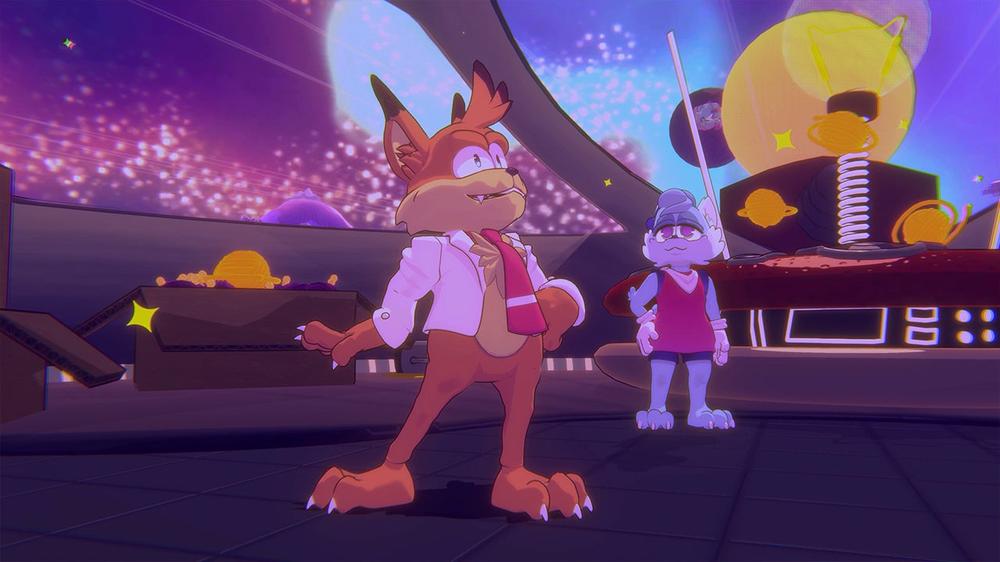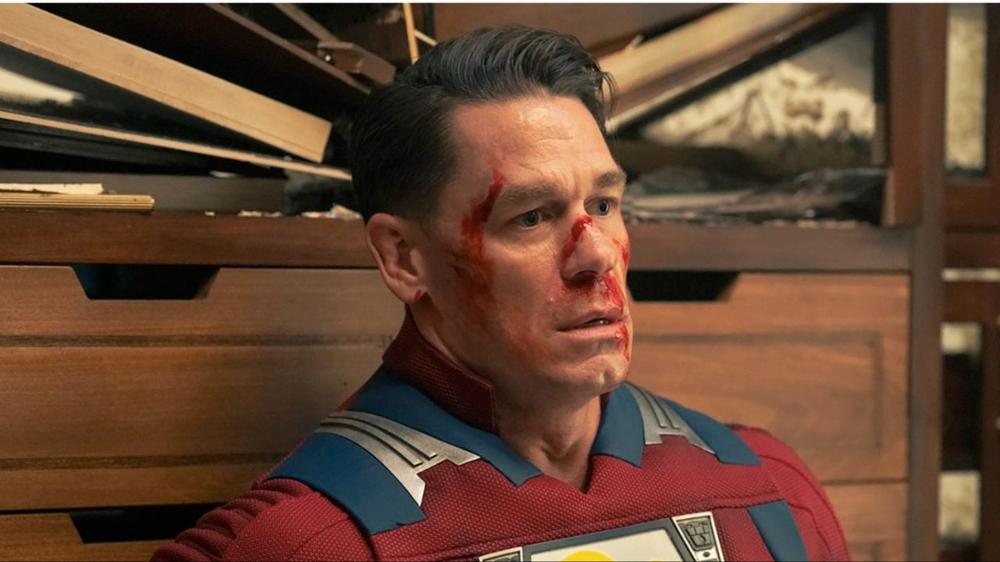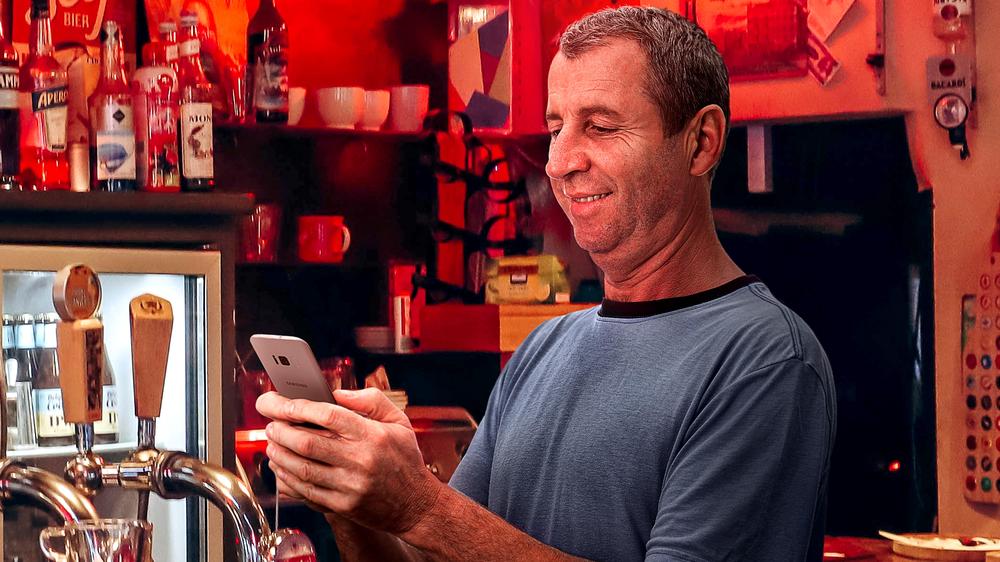Let’s get one thing out of the way: I hate Bubsy. Not Bubsy 4D, the interesting, vibrant game I’m actually previewing here, but rather Bubsy himself, the mangy, atrocious feline, a poisonous product of a cynical age of mascot marketing. Born in a dark hour when it seemed practically every video game company tied their fortunes to some clone of a clone of a Sonic sidekick, Bubsy has a well-deserved reputation as a D-tier cash-in character better left forgotten.
Fortunately, I have much more positive things to say about what I’ve seen of Bubsy 4D, a brand-new reconstruction of the furball’s tainted legacy that, while far from perfect, distinctively improves on Bubsy’s dubious past in almost every way. During a little over an hour with the Bubsy Steam demo, I found a great deal worth exploring... as well as some less encouraging signs.
It’s true: there are quite a lot of things to like about Bubsy 4D. It’s a colorful game with some cute creative accouterments scattered around the thematic worlds, like the knitted doily highways in the thread-and-needle themed opening stages. Voice work is solid (even if the script is a bit uneven) and my preview build was mostly glitch-free. The movement mechanics are fairly solid, outside of a little camera frustration on very long jumps to some small targets.
The tutorial area is concise and useful, a rare enough combination in games, teaching valuable skills with minimal exposition. Bubsy’s jump mechanics are logical but take a little getting used to – with various kinds of combinable jumps tied to a face button and both triggers – and it’s nice to be able to practice getting around with minimal risk or consequences before moving into the main campaign. Not that dying is that much of an issue... checkpoints (represented by litter boxes) are fairly generous, and even if he dies, Bubsy rarely respawns all that far from where he last fell.
And the obnoxious little cat gets around pretty well. Bubsy’s main strength is his airborne mobility. He can jump, double jump, leap forward and gently descend like a parachute, and pounce ahead to cover great horizontal distances... or do them all at the same time. Bubsy can also inflate himself into a ball to roll along hills and half-pipes, building momentum to execute even longer jumps. He can pounce on certain sheer surfaces and scramble up them, or claw at special points to gain mid-air distance boosts. He’s very capable of getting around, so much so that he can occasionally get ahead of the camera when stringing his pounce onto the end of a combo.
That pounce doubles as Bubsy’s primary attack, although in truth I found very few threats in Bubsy worth attacking. The demo stages are populated with plenty of steep jumps and acrobatic challenges, but there are very, very few enemies wandering about, and those that are present are braindead and quite easily dispatched. Platformers with few enemies aren’t unheard of (Portal, Super Meat Boy, and Thomas Was Alone come to mind) but it was still a little odd how remarkably vacant the colorful platforming environments felt without the usual crowds of Goombas, Koopas, or Giant Enemy Crabs. And while Bubsy’s level layouts are clean and competent, none of them approach the more subtle complexity of the classic platformers listed above.
And that’s my biggest question about where the full version of Bubsy 4D will ultimately land. The demo stages struggle somewhat in the fundamental level design, not in terms of the aesthetic production, but in the layouts themselves. The worlds, while adequately themed, are not especially well laid out. Most are obvious main paths with clearly-visible spokes and isolated islands. Scattered around the spokes are the most valuable collectables, while along the main path are myriad yarn-balls hovering in space. The results are mid-sized, explorable levels which should encourage curiosity and discovery... but often fail to do so.
The problem is not in the overall method, but its glaringly obvious lack of refinement. It is, in a sense, a return to the PlayStation 1-era world design of many mascot platformers, or perhaps more accurately, the kitchen-sink, haphazard-style popularized by many C64 and Amiga platform games, including classics like the Turrican series. Wherever the inspiration comes from, it doesn’t quite work yet here. The goals of each small section of a level feel repetitive, with the layout either too obvious or the goals not challenging enough. You can tell where you should probably go next, which is a good thing, but it’s often so obvious that the sense of discovery really suffers. There are a metric ton of collectables to seek out, but they’re rarely concealed in interesting ways or blocked by compelling challenges. And the lack of enemies greatly reduces the layered threats that might otherwise enhance the nuance and challenge.
Jumping between towers and collecting baubles is as old as video games, but what separates the mediocre from the classic is the refinement that takes place in implementing these rote mechanics into practice. After playing Astrobot and Donkey Kong Bananza within the past year, I can say that Bubsy 4D’s level design feels unfinished by comparison. The play areas, while visually interesting, are unpolished in their dynamic interactions. Leaping between obstacles and avoiding spikes feels clean, fair, and competent, but rarely feels exhilarating. There’s just enough openness to the worlds to obviously require tremendous testing and refinement on the part of the developers when designing obstacles that can be approached from multiple available angles and elevations, yet it’s painfully obvious this testing process has not come near final fruition. It’s not bad at all, it’s just not nearly as good as you know it could be. Within a few minutes of getting into Bubsy 4D, you realize you’ve done most of this before, but much better... and that’s not a feeling you want a video game to give you.
Fortunately, these are problems that can be addressed with time and attention on the part of the developers. This is a preview of a work in progress, not a review of a finished product, and there’s a lot of room yet for vast improvement before release next year. The potential is certainly there... Bubsy’s MASSIVE horizontal mobility is a great deal of fun in practice, and if the environments continue to be tightened up to match the cat’s core abilities, the team at Fabraz could be on to something really fun.
I do have one specific complaint about a design choice that doesn’t work so well: the demo’s only mandatory timed challenge, a racing romp across some steep blind hills and a bridge that pretty much demands memorization to be successfully completed. I had hoped that in the Year of Our Lord Two Thousand and Twenty-Five we might have moved beyond cramming an unskippable, fairly unintuitive, timed obstacle race into the golden path through a level, yet here we are with Bubsy 4D. These were not fun in the PlayStation 1 era, and 30 years later they are unforgivable sins.
Elsewhere, Bubsy purchases additional abilities from a central hub store run by his annoying niece and nephew, trading collectables for power-ups. My favorite of these was a Wile E. Coyote-inspired power that allowed me to float above empty space for a second like a Looney Tunes cartoon character who’s just run off a cliff, a flavorful and genuinely useful inclusion. It was thematically appropriate and adorable.
Finally, on the audio front, Bubsy 4D’s sample scores ranged from unremarkable to droning. The theme music for the first three stages started with an innocuous quality, but after a few loops became grating. I can only qualify the sound as something that began its life as elevator music that was then run through an N64 nostalgia filter and digitizer, and what came out the other side did little to add to the platforming experience. Maybe that one is just me and others might enjoy it more.
Voice work, on the other hand, is solid, and the script has a lot of nods to the mascot-platformer era. Bubsy maintains a heightened self-awareness throughout his new journey. He’s openly unenthusiastic about his latest quest for the golden fleece. He’s older, tired, and kind of over it all, and the comments that reflect that sense of 40-something exhaustion mostly work. The occasional sarcastic quips and poop jokes seem obligatory nods to the era that birthed Bubsy, but nothing I heard was laugh-out-loud funny. I did not like Bubsy’s family and cohorts, who sort of came across as worse iterations of Sonic’s terrible friends or DK’s annoying extended catalog of characters.
Overall, Bubsy 4D is, thus far, a bright, interesting template for a 3D platformer. Whether it will grow to fulfill its full potential before release is difficult to predict. The obvious care of the developers in treating the character with some reflection, even a possible wisp of dignity, works in 4D’s favor. Hopefully the final product will capitalize on the strong start evident in this demo.

 Peacemaker's Season 2 Finale May Have Revealed the Villain of James Gunn's Man of Tomorrow Movie, and We're Not Happy
Peacemaker's Season 2 Finale May Have Revealed the Villain of James Gunn's Man of Tomorrow Movie, and We're Not Happy